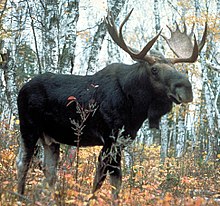Alcis (gods)
The Alcis (Proto-Germanic *alhiz) were a pair of young brothers worshipped by the Naharvali, an ancient Germanic tribe.
Name and origin[]

According to some scholars,[2][3] the name Alcis should be interpreted as a Latinized form of Proto-Germanic *alhiz (or *algiz), meaning 'elk (Alces alces)' (cf. Old Norse elgr, Old English eolh, Old High German elaho).[4][5] This would make the Alcis brothers the elk- or stag-gods.[2] Other scholars propose to link *alhiz to the Germanic root *alh- (cf. Goth. alhs 'temple', Old English ealgian 'to protect'; further Lith. alkas 'holy grove'), and thus to interpret the Alcis as 'protective' deities.[6][7][a]
The Alcis are generally regarded as a reflex of the Divine Twins, a pair of Indo-European youthful horsemen.[9][10][11] This may give support to the interpretation of the Alcis as elk-shaped or elk-gods,[10] even though the widespread description of the Divine Twins as rescuers, healers and protectors in other Indo-European mythologies does not rule out the second proposition either.[6] A speculative relation of the cult with the Germanic rune Algiz ('elk'), which is interpreted in the later Old Norse Sigrdrífomál as laeknishendr ('healing hands'), may be significant in our understanding of the etymological issue.[9]
Overview[]
According to Tacitus, the Alcis were a deity worshiped by the Naharvali.[2][12] The Roman historian states that their worship took place in a sacred grove, with a priest dressed in women's clothing presiding. The god(s) were given the name Alcis, and venerated as young men and brothers, but no images of the gods were used. A similarity with Castor and Pollux is noted by Tacitus, though he states the cult was indigenous, not derived from an outside influence.[13]
Among these last is shown a grove of immemorial sanctity. A priest in female attire has the charge of it. But the deities are described in Roman language as Castor and Pollux. Such, indeed, are the attributes of the divinity, the name being Alcis. They have no images, or, indeed, any vestige of foreign superstition, but it is as brothers and as youths that the deities are worshipped.
— Tacitus. Ch.43.[14]
See also[]
- Grevensvænge figurines
- Hengist and Horsa
- Haddingjar
- Divine twins
- Aśvins brothers of Hindu mythology
Footnotes[]
References[]
- ^ "elk, n. 1". Oxford English Dictionary (2nd ed.). 1989 [1891]. Retrieved January 15, 2021.
- ^ a b c Lurker 2004, p. 8.
- ^ Rübekeil 2017, p. 990.
- ^ Orel 2003, p. 14.
- ^ Kroonen 2013, p. 21.
- ^ a b Ström & Biezais 1975, pp. 87–89.
- ^ Simek 1984, p. 11.
- ^ Bliujienė, Audronė. "The Bog Offerings of the Balts: ‘I Give in Order to Get Back’". In: Archaeologia Baltica, Vol. 14: Underwater Archaeology in the Baltic Region. Dedicated to the 65th Birthday of Prof Habil. Dr Vladas Žulkus. Klaipėda: Klaipėda University Press, 2010. p. 141. ISSN 1392-5520.
- ^ a b Rosenfeld & Hauck 1984.
- ^ a b Simek 1984, pp. 11, 67.
- ^ West 2007, p. 190.
- ^ Smith 1880, p. 104 [text] A deity among the Naharvali, and ancient tribe. Grimm (Deutsche Mythol. p.39) considers Alcis in the passage of Tacitus to be the genitive of Alx, which, according to him, signifies a sacred grove, and is connected with the Greek άλσοε. Another Alcis occurs in Apollodorus, ii, 1 § 5. [L. S.] (Leonhard Schmitz)
- ^ Tacitus 1916, p. 22, 125.
- ^ Tacitus 1916, p. 22.
Sources[]
- Kroonen, Guus (2013). Etymological Dictionary of Proto-Germanic. Brill. ISBN 9789004183407.
- Lurker, Manfred (2004). The Routledge Dictionary of Gods and Goddesses, Devils and Demons. Routledge. ISBN 978-0-415-34018-2.
- Orel, Vladimir E. (2003). A Handbook of Germanic Etymology. Brill. ISBN 978-90-04-12875-0.
- Rosenfeld, Hellmut; Hauck, Karl (1984). "Dioskuren". Reallexikon der Germanischen Altertumskunde. Vol. 5 (2 ed.). De Gruyter. ISBN 978-3110096354.
- Rübekeil, Ludwig (2017). "The dialectology of Germanic". In Klein, Jared; Joseph, Brian; Fritz, Matthias (eds.). Handbook of Comparative and Historical Indo-European Linguistics. Vol. 2. Walter de Gruyter. ISBN 978-3-11-054243-1.
Simek, Rudolf (1984). Lexikon der germanischen Mythologie. A. Kröner. ISBN 3-520-36801-3.
- Smith, William, ed. (1880), "Alcis", Dictionary of Greek and Roman Biography and Mythology, John Murray, vol. 1
Ström, Åke V.; Biezais, Haralds (1975). Germanische und baltische Religion. Kohlhammer. ISBN 978-3-17-001157-1.
- Tacitus, Cornelius (1916), Reed Staurt, Duane (ed.), Tacitus - The Germania, with introduction and notes (in Latin and English), Macmillan
West, Martin L. (2007). Indo-European Poetry and Myth. Oxford University Press. ISBN 978-0-19-928075-9.
Further reading[]
- Ward, Donald J. (1968). "The "Alcis" of Tacitus' Germania". The Divine Twins: An Indo-European Myth in Germanic Tradition. Folklore Studies. University of California Press. pp. 42–45. ISSN 0068-6360.
- Germanic gods
- European mythology stubs
- Divine twins